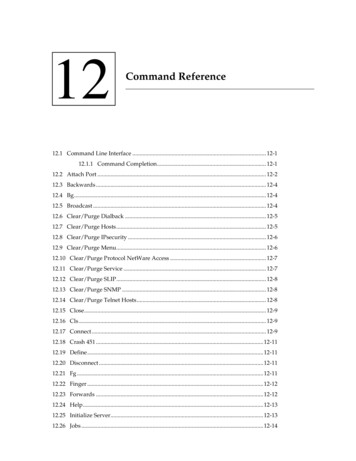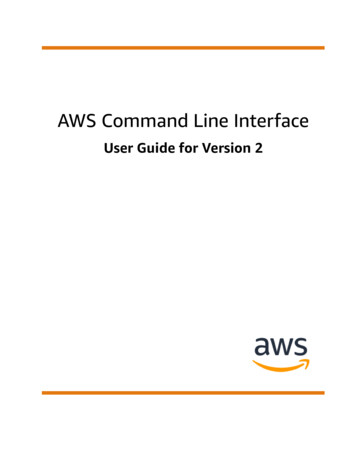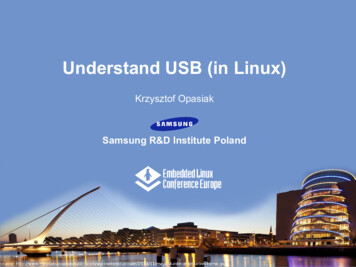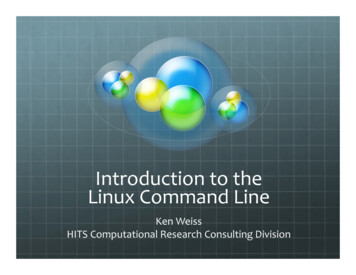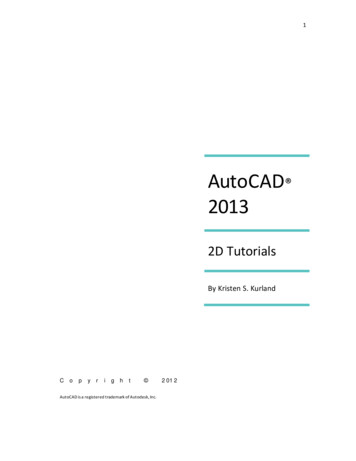
Transcription
Command Line Interface Reference Guide forCisco Unified Solutions Release 7.1(5)This document describes the Command Line Interface (CLI) commands that are available for the CiscoUnified Operating System.ContentsThis document comprises the following sections: Starting a CLI Session, page 1 CLI Basics, page 2 Delete Commands, page 6 File Commands, page 9 Run Commands, page 19 Set Commands, page 22 Show Commands, page 44 Unset Commnds, page 96 Utils Commands, page 98 Related Documentation, page 134 Obtaining Documentation, Obtaining Support, and Security Guidelines, page 134Starting a CLI SessionYou can access the Cisco Unified Operating System CLI remotely or locally: From a web client workstation, such as the workstation that you use for Cisco Unified OperatingSystem Administration, you can use SSH to connect securely to the Cisco Unified OperatingSystem.Americas Headquarters:Cisco Systems, Inc., 170 West Tasman Drive, San Jose, CA 95134-1706 USA
CLI Basics You can access the Cisco Unified Operating System CLI directly by using the monitor and keyboardthat you used during installation or by using a terminal server that is connected to the serial port.Use this method if a problem exists with the IP address.Before You BeginEnsure you have the following information that gets defined during installation: A primary IP address and hostname An administrator ID A passwordYou will need this information to log in to the Cisco IPT Platform.Perform the following steps to start a CLI session:Step 1Do one of the following actions depending on your method of access: From a remote system, use SSH to connect securely to the Cisco IPT Platform. In your SSH client,enterssh adminname@hostnamewhere adminname specifies the Administrator ID and hostname specifies the hostname that wasdefined during installation.For example, ssh admin@ipt-1. From a direct connection, you receive this prompt automatically:ipt-1 login:where ipt-1 represents the host name of the system.Enter your administrator ID.In either case, the system prompts you for a password.Step 2Enter your password.The CLI prompt displays. The prompt represents the Administrator ID; for example:admin:CLI BasicsThe following section contains basic tips for using the command line interface. Completing Commands, page 3 Getting Help on Commands, page 3 Exiting a Command with the Ctrl-C Key Sequence, page 4 Ending a CLI Session, page 4Command Line Interface Reference Guide for Cisco Unified Solutions Release 7.1(5)2OL-22241-01
CLI BasicsCompleting CommandsTo complete commands, use Tab: Enter the start of a command and press Tab to complete the command. For example, if you enter seand press Tab, set gets completed. Enter a full command name and press Tab to display all the commands or subcommands that areavailable. For example, if you enter set and press Tab, you see all the set subcommands. An *identifies the commands that have subcommands. If you reach a command, keep pressing Tab, and the current command line repeats; this indicatesthat no additional expansion is available.Getting Help on CommandsYou can get two kinds of help on any command: Detailed help that includes a definition of the command and an example of its use Short query help that includes only command syntaxProcedureTo get detailed help, at the CLI prompt, enterhelp commandWhere command specifies the command name or the command and parameter. See Example 1-1.NoteIf you enter the help command without specifying the name of a particular command as the optionalparameter, the system provides information about the CLI system.To query only command syntax, at the CLI prompt, entercommand?Where command represents the command name or the command and parameter. See Example 1-2.NoteIf you enter a ? after a menu command, such as set, it acts like the Tab key and lists the commands thatare available.Example 1-1Detailed Help Example:admin:help file list activelogactivelog help:This will list active logging filesoptions are:page- pause outputdetail - show detailed listingCommand Line Interface Reference Guide for Cisco Unified Solutions Release 7.1(5)OL-22241-013
CLI Basicsreverse - reverse sort orderdate- sort by datesize- sort by sizefile-spec can contain '*' as wildcardsExample:admin:file list activelog02 Dec,2004 12:00:5902 Dec,2004 12:00:5916 Nov,2004 21:45:4327 Oct,2004 11:54:33dir count 2, file countExample 1-2platform dir dir 8,55747,916 2detaildrflogenGui.logstartup.logQuery Example:admin:file list activelog?Syntax:file list activelog file-spec [options]file-specmandatoryfile to viewoptionsoptionalpage detail reverse [date size]Exiting a Command with the Ctrl-C Key SequenceYou can stop most interactive commands by entering the Ctrl-C key sequence, as shown in the followingexample:Example 3Exiting a Command with Ctrl-Cadmin:utils system upgrade initiateWarning: Do not close this window without first exiting the upgrade command.Source:1) Remote Filesystem2) DVD/CDq) quitPlease select an option (1 - 2 or "q" ):Exiting upgrade command. Please wait.Control-C pressedadmin:NoteIf you execute the command utils system switch-version and enter Yes to start the process, enteringCtrl-C exits the command but does not stop the switch-version process.Ending a CLI SessionAt the CLI prompt, enter quit. If you are logged in remotely, you get logged off, and the ssh session getsdropped. If you are logged in locally, you get logged off, and the login prompt returns.Command Line Interface Reference Guide for Cisco Unified Solutions Release 7.1(5)4OL-22241-01
CLI BasicsThe following sections list and describe the CLI commands that are available for the Cisco UnifiedOperating System.ConventionsThis document uses the following conventions:ConventionDescriptionboldface fontCommands and keywords are in boldface.italic fontArguments for which you supply values are in italics.[ ]Elements in square brackets are optional.{x y z}Alternative keywords are grouped in braces and separated by vertical bars.[x y z]Optional alternative keywords are grouped in brackets and separated byvertical bars.stringA nonquoted set of characters. Do not use quotation marks around thestring or the string will include the quotation marks.screenfontboldface screenitalic screen fontTerminal sessions and information the system displays are in screen font.fontInformation you must enter is in boldface screen font.Arguments for which you supply values are in italic screen font.This pointer highlights an important line of text in an example. The symbol represents the key labeled Control—for example, the keycombination D in a screen display means hold down the Control keywhile you press the D key. Nonprinting characters, such as passwords, are in angle brackets.Notes use the following conventions:NoteMeans reader take note. Notes contain helpful suggestions or references to material not covered in thepublication.Timesavers use the following conventions:TimesaverMeans the described action saves time. You can save time by performing the action described in theparagraph.Tips use the following conventions:TipMeans the information contains useful tips.Cautions use the following conventions:Command Line Interface Reference Guide for Cisco Unified Solutions Release 7.1(5)OL-22241-015
Delete CommandsCautionMeans reader be careful. In this situation, you might do something that could result in equipmentdamage or loss of data.Warnings use the following conventions:WarningThis warning symbol means danger. You are in a situation that could cause bodily injury. Before youwork on any equipment, you must be aware of the hazards involved with electrical circuitry andfamiliar with standard practices for preventing accidents.Delete CommandsThis section contains descriptions of the following commands: delete account, page 6 delete cuc futuredelivery (Cisco Unity Connection Only), page 6 delete cuc locale (Cisco Unity Connection Only), page 7 delete dns, page 7 delete ipsec policy group, page 8 delete ipsec policy name, page 8 delete process, page 9 delete smtp, page 9delete accountThis command allows you to delete an administrator account.Command Syntaxdelete account account-nameParameters account-name represents the name of an administrator account.RequirementsCommand privilege level: 4Allowed during upgrade: Nodelete cuc futuredelivery (Cisco Unity Connection Only)This command deletes all messages that have been marked for future delivery.Command Syntaxdelete cuc futuredeliveryCommand Line Interface Reference Guide for Cisco Unified Solutions Release 7.1(5)6OL-22241-01
Delete CommandsRequirementsCommand privilege level: 1Allowed during upgrade: YesExampledelete cuc futuredeliveryDeleting File : DC-9BAF-41FC55D89593.emlDeleting File : DC-A0E6-D1FD55D89593.emlFiles : Found 2, Deleted 2Note: Files that are in use cannot be deleteddelete cuc locale (Cisco Unity Connection Only)SKThis command deletes the specified locale and all of the associated files and settings from Connection.Command Syntaxdelete cuc locale locale-idParameters locale-id represents the ID of the locale that you want to delete.For a list of installed locales and their IDs, run the show cuc locales (Cisco Unity ConnectionOnly) command. Be aware that locale IDs are case sensitive.Usage GuidelinesBefore you run this command, you must stop the Connection Conversation Manager and ConnectionMixer services. After you run this command, you must restart the Connection Conversation Manager andConnection Mixer services.RequirementsCommand privilege level: 1Allowed during upgrade: YesExampleThe following example deletes the en-GB locale and all of the associated files and settings.delete cuc locale en-GBen-GB uninstalleddelete dnsThis command allows you to delete the IP address for a DNS server.Command Syntaxdelete dns ip-addressCommand Line Interface Reference Guide for Cisco Unified Solutions Release 7.1(5)OL-22241-017
Delete CommandsParameters ip-address represents the IP address of the DNS server that you want to delete.Usage GuidelinesThe system asks whether you want to continue to execute this command.CautionIf you continue, this command causes a temporary loss of network connectivity.RequirementsCommand privilege level: 1Allowed during upgrade: Nodelete ipsec policy groupThis command deletes all policies within the specified group.Command Syntaxdelete ipsec policy group [group]Parameters [group] (mandatory) [ALL or group]Usage GuidelinesUse the all option to delete all the groups.RequirementsCommand privilege level : 1Allowed during upgrade: Nodelete ipsec policy nameThis command deletes an ipsec policy with given policy name.Command Syntaxdelete ipsec policy name [policy name]Parameters [policy name] (mandatory) [ALL or policy name]RequirementsCommand privilege level: 1Allowed during upgrade: NoCommand Line Interface Reference Guide for Cisco Unified Solutions Release 7.1(5)8OL-22241-01
File Commandsdelete processThis command allows you to delete a particular process.Command Syntaxdelete process process-id [force terminate crash]Parameters process-id represents the process ID number.Options force—Tells the process to stop. terminate—Tells the operating system to terminate the process. crash—Crashes the process and produces a crash dump.Usage GuidelinesNoteUse the force option only if the command alone does not delete the process and use the terminate optiononly if force does not delete the process.RequirementsCommand privilege level: 1Allowed during upgrade: Yesdelete smtpThis command allows you to delete the SMTP host.Command Syntaxdelete smtpRequirementsCommand privilege level: 1Allowed during upgrade: NoFile CommandsThis section contains descriptions of the following commands: file check, page 10 file delete, page 10 file dump, page 11 file fragmentation sdi, page 13 file fragmentation sdl, page 13Command Line Interface Reference Guide for Cisco Unified Solutions Release 7.1(5)OL-22241-019
File Commands file get, page 14 file list, page 15 file search, page 16 file tail, page 17 file view, page 18file checkThis command checks the /usr directory tree to see whether any files or directories have been added,removed, or changed in size since the last fresh installation or upgrade and displays the results.Command Syntaxfile check [detection-size-kb]Optionsdetection-size-kb specifies the minimum file size change that is required for the command to display thefile as changed.Usage GuidelinesThe command notifies you about a possible impact to system performance and asks you whether youwant to continue.CautionBecause running this command can affect system performance, Cisco recommends that you run thecommand during off-peak hours.The display includes both deleted and new files.DefaultsThe default value of detection-size-kb specifies 100 KB.RequirementsCommand privilege level: 0Allowed during upgrade: Nofile deleteThis command deletes one or more files.Command Syntaxfile deleteactivelog directory/filename [detail] [noconfirm]dir tftp directory [detail]inactivelog directory/filename [detail] [noconfirm]install directory/filename [detail] [noconfirm]Command Line Interface Reference Guide for Cisco Unified Solutions Release 7.1(5)10OL-22241-01
File Commandslicense filename [detail]tftp directory/filename [detail]Parameters activelog specifies a log on the active side. dir tftp directory deletes the TFTP directory that is specified by directory. You cannot enter thewildcard character (*) in directory. inactivelog specifies a log on the inactive side. install specifies an installation log. license filename deletes the license file that is specified by license. You can enter the wildcardcharacter (*) as filename to delete all the license files. tftp specifies a TFTP file. directory/filename specifies the path and filename of the file(s) to delete. You can use the wildcardcharacter, *, for filename.Options detail—Displays a listing of deleted files with the date and time. noconfirm—Deletes files without asking you to confirm each deletion.Usage GuidelinesCautionYou cannot recover a deleted file except, possibly, by using the Disaster Recovery System.You get prompted for confirmation after entering the command. You cannot delete directories or filesthat are in use.If you delete a TFTP data file on the inactive side, you may need to manually restore that file if youswitch versions to the inactive side.RequirementsCommand privilege level: 1Allowed during upgrade: YesExampleThe following example deletes the install log.file delete install install.logfile dumpThis command dumps the contents of a file to the screen, a page at a time.Command Syntaxfile dumpactivelog directory/filename [detail] [hex]Command Line Interface Reference Guide for Cisco Unified Solutions Release 7.1(5)OL-22241-0111
File Commandsactivelog audit directory/filename [detail] [hex]inactivelog directory/filename [detail] [hex]inactivelog audit directory/filename [detail] [hex]install directory/filename [detail] [hex]sftpdetails filename [hex] [regexp expression] [recent]tftp directory/filename [detail] [hex]Parameters activelog specifies a log on the active side. activelog audit specifies an audit log on the active side. inactivelog specifies a log on the inactive side. inactivelog audit specifies an audit log on the inactive side. install specifies an installation log. sftpdetails specifies SFTP-related files. tftp specifies a TFTP file. directory/filename specifies the path and filename of the file to dump. You can use the wildcardcharacter, *, for filename as long as it resolves to one file. filename specifies the filename of the file to dump.Options detail—Displays listing with the date and time hex—Displays output in hexadecimal regexp expression—Displays only the lines in the file that match the regular expression expression. recent—Displays the most recently modified file in the directory.Usage GuidelinesTo determine which files you can dump with the sftpdetails parameter, first enter the followingcommand:file list sftpdetails *The output lists the filenames that you can dump.RequirementsCommand privilege level: 1 for logs, 0 for TFTP filesAllowed during upgrade: YesExampleThis command dumps contents of file cdrIndex.idx.file dump activelog cm/cdr/ cdrIndex.idxCommand Line Interface Reference Guide for Cisco Unified Solutions Release 7.1(5)12OL-22241-01
File Commandsfile fragmentation sdiThis command displays file fragmentation information about SDI log files.Command Syntaxfile fragmentation sdiall outfilenamefile filename {verbose}most fragmented numbermost recent numberParameters all records information about all files in the directory in the file that is specified by outfilename. file displays information about the file that is specified by filename. most fragmented displays information about the most fragmented files. most recent displays information about the most recently logged fragmented file. number specifies the number of files to list.Options verbose—Displays more detailed information.RequirementsCommand privilege level: 1Allowed during upgrade: Yesfile fragmentation sdlThis command displays file fragmentation information about SDL log files.Command Syntaxfile fragmentation sdlall outfilenamefile filename {verbose}most fragmented numbermost recent numberParameters all records information about all files in the directory in the file that is specified by outfilename. file displays information about the file that is specified by filename. most fragmented displays information about the most fragmented files. most recent displays information about the most recently logged fragmented file. number specifies the number of files to list.Command Line Interface Reference Guide for Cisco Unified Solutions Release 7.1(5)OL-22241-0113
File CommandsOptions verbose—Displays more detailed informationRequirementsCommand privilege level: 1Allowed during upgrade: Yesfile getThis command sends the file to another system by using SFTP.Command Syntaxfile getactivelog directory/filename [reltime] [abstime] [match] [recurs]activelog audit directory/filename [reltime] [abstime] [match] [recurs]inactivelog directory/filename [reltime] [abstime] [match] [recurs]inactivelog audit directory/filename [reltime] [abstime] [match] [recurs]install directory/filename [reltime] [abstime] [match] [recurs]license filename [reltime] [abstime] [match] [recurs] [compress]partBsalog directory/filename [reltime] [abstime] [match] [recurs]salog directory/filename [reltime] [abstime] [match] [recurs]tftp directory/filename [reltime] [abstime] [match] [recurs]Parameters activelog specifies a log on the active side. activelog audit specifies an audit log on the active side. inactivelog specifies a log on the inactive side. inactivelog audit specifies an audit log on the inactive side. install specifies an installation log. license specifies license file. partBsalog specifies the partBsalog log directory. salog specifies the salog log directory. tftp specifies a TFTP file. directory/filename specifies the path to the file(s) to delete. You can use the wildcard character, *,for filename as long as it resolves to one file.Options abstime—Absolute time period, specified as hh:mm:MM/DD/YY hh:mm:MM/DD/YY reltime—Relative time period, specified as minutes hours days weeks months value match—Match a particular string in the filename, specified as string value recurs—Get all files, including subdirectoriesCommand Line Interface Reference Guide for Cisco Unified Solutions Release 7.1(5)14OL-22241-01
File Commands compress—Transfer files as compressed fileUsage GuidelinesAfter the command identifies the specified files, you get prompted to enter an SFTP host, username, andpassword.RequirementsCommand privilege level: 0Allowed during upgrade: YesExamplesThis command gets all files in the activelog operating system directory that match the string “plat”.admin: file get activelog platform match platThis command gets all operating system log files for a particular time period.admin: file get activelog platform/log abstime 18:00:10/20/13 18:00:10/21/13file listThis command lists the log files in an available log directory.Command Syntaxfile listactivelog directory [page] [detail] [reverse] [date size]activelog audit directory [page] [detail] [reverse] [date size]inactivelog directory [page] [detail] [reverse] [date size]inactivelog audit directory [page] [detail] [reverse] [date size]install directory [page] [detail] [reverse] [date size]license filename [page] [detail] [reverse] [date size]partBsalog directory [page] [detail] [reverse] [date size]salog directory [page] [detail] [reverse] [date size]tftp directory [page] [detail] [reverse] [date size]Parameters activelog specifies a log on the active side. activelog audit specifies audit logs on the active side. inactivelog specifies a log on the inactive side. inactivelog audit specifies audit logs on the inactive side. install specifies an installation log. license displays the license file that is specified by license. You can enter the wildcard character (*)as filename to list all the license files. partBsalog specifies the partBsalog log directory.Command Line Interface Reference Guide for Cisco Unified Solutions Release 7.1(5)OL-22241-0115
File Commands salog specifies the salog log directory. tftp specifies a TFTP file. directory specifies the path to the directory to list. You can use a wildcard character, *, for directoryas long as it resolves to one directory.Options detail—Long listing with date and time date—Sort by date size—Sort by file size reverse—Reverse sort direction page—Displays the output one screen at a time.RequirementsCommand privilege level: 1 for logs, 0 for TFTP filesAllowed during upgrade: YesExamplesThis example lists operating system log files with details.file list activelog platform/log page detailThis example lists directories in CDR repository.file list activelog cm/cdr repositoryThis example lists CDR files in a specified directory by size.file list activelog cm/cdr repository/processed/20050812 sizeIn Cisco Unity Connection and in Cisco Unified Communications Manager Business Edition, thisexample lists all files in the cuc log directory.file list activelog cuc *file searchThis command searches the content of a log and displays the matching lines a page at a time.Command Syntaxfile searchiactivelog directory/filename reg-exp [abstime hh:mm:ss mm/dd/yyyy hh:mm:ss mm/dd/yyyy][ignorecase] [reltime {days hours minutes} timevalue]activelog audit directory/filename reg-exp [abstime hh:mm:ss mm/dd/yyyy hh:mm:ss mm/dd/yyyy][ignorecase] [reltime {days hours minutes} timevalue]inactivelog directory/filename reg-exp [abstime hh:mm:ss mm/dd/yyyy hh:mm:ss mm/dd/yyyy][ignorecase] [reltime {days hours minutes} timevalue]inactivelog audit directory/filename reg-exp [abstime hh:mm:ss mm/dd/yyyy hh:mm:ssmm/dd/yyyy] [ignorecase] [reltime {days hours minutes} timevalue]Command Line Interface Reference Guide for Cisco Unified Solutions Release 7.1(5)16OL-22241-01
File Commandsinstall directory/filename reg-exp [abstime hh:mm:ss mm/dd/yyyy hh:mm:ss mm/dd/yyyy][ignorecase] [reltime {days hours minutes} timevalue]tftp directory/filename reg-exp [abstime hh:mm:ss mm/dd/yyyy hh:mm:ss mm/dd/yyyy][ignorecase] [reltime {days hours minutes} timevalue]Parameters activelog specifies a log on the active side. activelog audit specifies an audit log on the active side. inactivelog specifies a log on the inactive side. inactivelog audit specifies a log on the inactive side. install specifies an installation log. tftp specifies a TFTP file. reg-exp represents a regular expression. directory/filename represents the path to the file(s) to search. You can use the wildcard character, *,to represent all or part of the filename.Options abstime—Specifies which files to search based on file creation time. Enter a start time and an endtime. days hours minutes—Specifies whether the file age is in days, hours, or minutes. ignorecase—Ignores case when searching. reltime—Specifies which files to search based on file creation time. Enter the age of files to search. hh:mm:ss mm/dd/yyyy—An absolute time, in the format hours:minutes:seconds month/day/year. timevalue—The age of files to search. Specify the unit of this value with the {days hours minutes} option.Usage GuidelinesWrite the search term in the form of a regular expression, which is a special text string for describing asearch pattern.If the search term is found in only one file, the filename appears at the top of the output. If the searchterm is found in multiple files, each line of the output begins with the filename in which the matchingline was found.RequirementsCommand privilege level: 0Allowed during upgrade: YesExamplefile search activelog platform/log/platform.log Err[a-z] ignorecasefile tailThis command tails (prints the last few lines) of a log file.Command Line Interface Reference Guide for Cisco Unified Solutions Release 7.1(5)OL-22241-0117
File CommandsCommand Syntaxfile tailactivelog directory/filename [detail] [hex] [lines]inactivelog directory/filename [detail] [hex] [lines]install directory/filename [detail] [hex] [lines]tftp directory/filename [detail] [hex] [lines]Parameters activelog specifies a log on the active side. inactivelog specifies a log on the inactive side. install specifies an installation log. tftp specifies a TFTP file. directory/filename specifies the path to the file to tail. You can use the wildcard character, *, forfilename as long as it resolves to one file.Options detail—Long listing with date and time hex—Hexadecimal listing lines—Number of lines to displayRequirementsCommand privilege level: 1 for logs, 0 for TFTP filesAllowed during upgrade: YesExampleThis example tails the operating system CLI log file.file tail activelog platform/log/cli00001.logfile viewThis command displays the contents of a file.Command Syntaxfile viewactivelog directory/filenameactivelog audit directory/filenameinactivelog directory/filenameinactivelog audit directory/filenameinstall directory/filenamelicense filenamesystem-management-logCommand Line Interface Reference Guide for Cisco Unified Solutions Release 7.1(5)18OL-22241-01
Run Commandstftp directory/filenameParameters activelog specifies a log on the active side. activelog audit specifies an audit log on the active side. inactivelog specifies a log on the inactive side. inactivelog audit specifies an audit log on the inactive side. install specifies an installation log. license filename views the license file that is specified by license. You can enter the wildcardcharacter (*) as filename to view all the license files. system-management-log displays the contents of the Integrated Management Logs (IML). tftp specifies a TFTP file. directory/filename specifies the path to the file to view. You can use the wildcard character, *, forfilename as long as it resolves to one file.Usage GuidelinesCautionDo not use this command to view binary files because this can corrupt the terminal session.RequirementsCommand privilege level: 0Allowed during upgrade: YesExamplesThis example displays the install log.file view install install.logThis example displays a particular CDR file.file view activelog /cm/cdr repository/processed/20058012/{filename}Run CommandsThis section contains descriptions of the following commands: run cuc dbquery (Cisco Unity Connection Only), page 20 run cuc sysagent task (Cisco Unity Connection Only), page 20 run cuc vui rebuild (Cisco Unity Connection Only), page 21 run loadxml, page 21 run sql, page 22Command Line Interface Reference Guide for Cisco Unified Solutions Release 7.1(5)OL-22241-0119
Run Commandsrun cuc dbquery (Cisco Unity Connection Only)SKThis command runs an SQL query and displays the results.Command Syntaxrun cuc dbquery database name sql statement [page]Parameters database name specifies the database that sql statement operates on. Be aware that database namesare case sensitive. Connection databases include– unitydirdb—contains the directory and configuration data.– unitydyndb—contains dynamic data that Connection uses internally.– unitymbxdb1 to unitymbxdb5—contains the data about the current voice messages in thecorresponding mailbox store, including pointers to the audio files that are stored in the filesystem. If only one mailbox store is configured, the name of the mailbox store database isalways unitymbxdb1.– unityrptdb—contains audit log data. sql statement specifies the SQL query that you want to run.Option page—Causes the output to display one page at a time. Be aware that Be aware that page is casesensitive.RequirementsCommand privilege level: 1Allowed during upgrade: YesExampleThe following example runs the SQL query select alias from vw usertemplate on the unitydirdbdatabase.run cuc dbquery unitydirdb select alias from vw TemplateVoiceMailUserTemplaterun cuc sysagent task (Cisco Unity Connection Only)SKThis command runs a Sysagent task.Command Syntaxrun cuc sysagent task task nameCommand Line Interface Reference Guide for Cisco Unified Solutions Release 7.1(5)20OL-22241-01
Run CommandsParameters task name specifies the name of the sysagent task that you want to run.For a list of Sysagent tasks, run the command show cuc sysagent task list (Cisco Unity ConnectionOnly). Be aware that sysagent task names are case sensitive.RequirementsCommand privilege level: 1Allowed during upgrade: YesExampleThe following example runs the Sysagent task CleanDeletedMessagesTask.run cuc sysagent task CleanDeletedMessagesTaskCleanDeletedMessagesTask startedrun cuc vui rebuild (Cisco Unity Connection Only)TF, added for 7.0This command instructs the voice recognition transport utility to immediately rebuild the voicerecognition name grammars w
3 Command Line Interface Reference Guide for Cisco Unified Solutions Release 7.1(5) OL-22241-01 CLI Basics Completing Commands To complete commands, use Tab: † Enter the start of a command and press Tab to complete the command. For example, if you enter se and press Tab, set gets completed. † Enter a full command name and press Tab to display all the commands or subcommands that are

